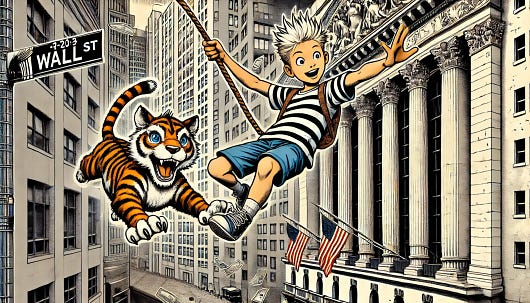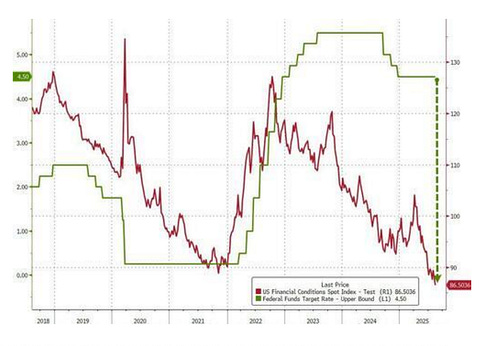"Too Big to Fail" in Jackson Hole (Capital Wave)I was tempted to use the words "Fear and Loathing..." so let's use something just as damning and more financially relevant as we approach this mess of a financial system.Good Morning: And thus… we have arrived at my Super Bowl. The Jackson Hole Symposium… A legendary three-day event that sets the tone for monetary policy… and thus the direction of markets for the foreseeable future. Today, I get to tell you the blunt truth of what they’re doing out there in Jackson Hole, Wyoming. They’re not trying to win contests for “Best Academic Paper” on Open Market Operations. No one’s going to be applying for a new job at a central bank. No… this is the line in the sand. As John Tuld screams in Margin Call… “This is It.” This is the start of the money printer… it is firing up again in the distance… Do you hear… the BRRRRR? The Ghosts of 1987I have spent the last year re-studying crises before 2008. As you know, there is a distinct sell-off pattern to almost every major downturn dating back to the Great Financial Crisis. So, I went back further… and 1987 carried the same pattern as well. The more I dug into 1987, the more I couldn’t help but notice that a lot of the voices I follow are comparing the post Plaza Accord (1985) environment to today. Liquidity master Michael Howell sees it. Permabear Albert Edwards is yelling about it. Paul Tudor Jones, who made his fortune predicting Black Monday, is warning about it. Even the Fed admits hedge funds nearly broke the market in August. They're not being paranoid. They’re looking at history to see what comes next. This morning, Michael Howell laid out the parallels at Jackson Hole. We're 34 months into a liquidity cycle that's running on fumes. In 1987, the German Bundesbank was the villain threatening to raise rates that helped bring the markets to their knees. Today, it’s the U.S. Federal Reserve. Albert Edwards from Société Générale, the guy who called the dot-com bubble, says we could get a 1987-style crash without even needing a recession. Just high valuations meeting shrinking liquidity. That's it. That's the recipe. Meanwhile, we have to watch what’s going on with Treasury yields, as higher yields impact collateral, which affects leverage, which impacts valuations.... The fear is that the 10-year starts to climb back to 4.5% and the 30-year touches 5%, raising alarms about long-term financing issues and inflation. Without immediate Fed cuts and turning on the printer… There is a parallel to the 1980s that exists… not right away… not tomorrow… but as liquidity starts to drain (as soon as next year). Watch the bond market., The Hedge Fund Time BombThe serious problem here is the leverage and the structure of the financial system. The Federal Reserve has admitted what everyone knows. Highly leveraged hedge funds amplified the August 2024 selloff by dumping positions to meet volatility targets. Janet Yellen said the exact same thing in April 2025 - noting that leveraged funds had been unwinding positions that amplified the sharp decline around April 7. In these situations, low liquidity turned a hiccup into a heart attack. Meanwhile, Henry Maxey from Ruffer says the reality of today’s markets compounds the problems. It’s not just the 1987 playbook… it’s one on steroids... We now have algorithmic trading, pro-cyclical margin requirements, and multi-strategy hedge funds all programmed to sell at the same time. (Again, it all follows the same pattern, and Maxey’s observations seem to align with my conclusion on why.) It's a synchronized swimming competition where everyone drowns together. Then there’s Mark Spitznagel. He’s the black swan guy at Universa, and the person whose strategy returned thousands of percent every time these markets unwind. He argues that when the Fed finally cuts, it means recession is already here. The cuts themselves will trigger the collapse. That’s pretty brutal… Damned if they do, damned if they don't. But the question is WHY? The $2 Trillion Basis Trade BombThe issue at the core is the bond market… When Janet Yellen said that we had all these hedge funds unwinding bond positions in April, the journalist at the Australian Review should have spit out of his coffee… and asked the woman: “Why are hedge funds leveraging up on the risk free asset in global finance.” As I’ve said time and time again, the biggest crises always end up around the safe assets: Land, bonds, housing… There’s no collapse in the financial system because of horse racing or Beanie Babies… It all comes down to this Basis trade. The Fed and the government tolerate that hedge funds load up on Treasury bills and bonds, and leverage up to try to make a few more percentage points. In exchange, this creates demand for U.S. debt and keeps yields lower. Well, funds have over $1 trillion in Treasury basis trades. Again, these are leveraged bets that Treasury futures and cash bonds will converge. When they don't, funds blow up. Regulators are so worried they're floating a "basis purchase facility" where the Fed would bail out these trades. This is a bailout system for this basis trade… which is the definition of moral hazard and will only encourage MORE basis trades. So, these people know the bomb exists, and they're building the defusal kit. And encouraging more bomb makers to emerge… Impossible MathHere’s where the real trouble is… As Howell noted, the U.S. Treasury Department will need to restore its cash balance this year. To get to $850 billion, they must drain about a half-trillion ($500 billion) from the financial markets. The issue is that foreign buyers don’t want U.S. debt… they want U.S. assets. Meanwhile, traditional buyers aren’t rushing to buy U.S. debt for many reasons... Can’t say that it’s attractive to lend the government money at 4.3% when inflation concerns continue to emerge… So… the central planners have to get creative. They want hedge funds buying on the longer tail and stablecoin operators on the front end. But the problem is that hedge funds are ALREADY too leveraged at the moment… So where will the demand come from? Meanwhile, we are heading into Jackson Hole with the loosest financial conditions of the post-COVID ERA. The U.S. Financial Conditions Spot Index shows that we’ve ramped up a mess… People think that we’ve been engaging in Quantitative Tightening in 2025… But Howell notes a $250 billion drop on the balance sheet, but an increase of Federal Reserve liquidity by $350 billion through some accounting shenanigans. How’d that happen? They drained the Treasury General Account and stripped the Reverse Repo facility. It's monetary three-card monte. Then there’s the trade war... Paul Tudor Jones has said that tariff wars will act as a huge trigger… If China retaliates, supply chains could break. Then, inflation spikes, and the Fed is forced to choose between fighting inflation and saving U.S. markets. In 1987, they chose to fight inflation. But today, with $37 trillion in debt, that option doesn't exist. The Only Hand LeftWe all see what’s coming… what has to be done… And it’s blisteringly insane… The Fed is going to have to… and a lot of it feels like England back in 2022…
The conclusion is that Jackson Hole becomes a distraction... They'll announce some new framework to distract everyone. But behind the curtain, the money printer is firing up… and it’s going to take the equity markets higher... When Edwards, Tudor Jones, Spitznagel, and Howell all see the same thing, you pay attention. These guys all have different views of the world… different angles… different expectations… and different market approaches… They're not coordinating. They're independently arriving at the same conclusion… The market structure that caused the 1987 crash is back, but worse. The difference? In 1987, we could take the pain and rebuild. Today, we're too leveraged, too indebted, and too fragile. The Fed knows this. The Treasury knows this. The hedge funds definitely know this. They're not managing an economy anymore. They're managing a financial Ponzi scheme that's now too big to fail. Let’s get to the market update… Continue reading this post for free in the Substack app |
Subscribe to:
Post Comments (Atom)







0 Response to ""Too Big to Fail" in Jackson Hole (Capital Wave)"
Post a Comment